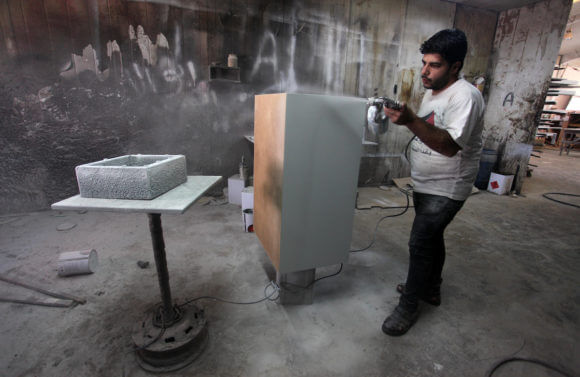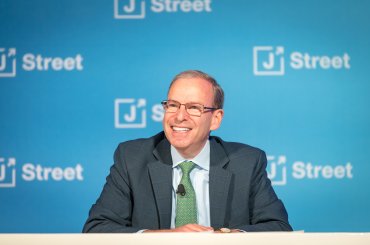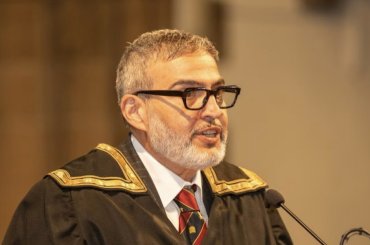We write to you from occupied Palestine, a beautiful land with beautiful people who are engaged in building an economy to serve their burgeoning state.
We know all too well the real-life hurdles Palestinians must overcome to simply do business. We just visited a handful of firms in the West Bank and saw their reality firsthand through our work with Americans for a Vibrant Palestinian Economy or AVPE, a non-profit that builds bridges between American and Palestinian businesspeople.
The World Bank cites Israeli restrictions on trade in the West Bank and Gaza as a major factor in “crippling” Palestinian economic development. For the past 25 years we saw billions of dollars invested in the name of economic development. The result? The recent Food Security Sector index reports nearly 70 percent of families are food insecure in Gaza. The World Bank found unemployment exceeded 50 percent in Gaza and 30 percent in the West Bank.
However, let us not concentrate on reports and statistics alone. AVPE focuses on assisting specific businesses, which means we see the effects of occupation up close. We want to share some of those stories to paint a picture of just how hard it can be to build these bridges, as well as to depict how amazingly resilient the Palestinian business community is.
Hussein owns a chocolate factory in Anabta, Al Hijaz. We work with Hussein to access the tools and knowledge necessary for U.S. market entry. This not only means jumping through all the normal hoops of exporting to the U.S. (FDA Regulations, ISO Certification, etc.) but also facing the stark reality of Israeli control. Restricted access to water and electricity (both sold by Israel to Palestinians) can prevent the factory from working efficiently. Prolonged waits at checkpoints can incur extra costs as transporting chocolate in a hot environment means expensive refrigerated transport.
Before Al Hijaz’s product has even left the continent, it suffers unnecessary expenses merely because it is a Palestinian product. Occupation means that the movement of all goods and all ports are controlled by Israel. Al Hijaz is forced to use Israeli transport companies to reach export markets. Adding insult to injury, Palestinians are often a captive market for Israeli companies. Holding an economy hostage has its benefits.
Another of AVPE’s beneficiary companies, Transcend, a Bethlehem-based technology company founded in 2010, has been able to grow their client base across the globe, including a high-profile academic association in the U.S. Despite what seems to many as policies aimed at de-developing Palestine, a few companies have endured with a combination of grit, hard work, and perseverance. Beit Jala Pharmaceuticals, another firm located near Bethlehem that AVPE works with, is unable to produce certain medicines due to restrictions on the import of necessary raw materials. Meanwhile, the pharmaceutical industry in Israel is one of their largest sectors, exporting products to the U.S. and across the globe.


We realize most people don’t understand clearly the web woven by Israeli occupation. It is an intricate web with little useful purpose one can make any sense of. Nearly 80 percent of Palestinian exports are destined for the Israeli market. This may be a surprising fact to many, but it is common for landlocked nations to majority trade with their neighbors.
What is surprising is how interlinked and interdependent the two economies are. AVPE recently began working with the Palestinian Plastic Industries Union, based in Hebron. After visiting with one factory owner he said something that stuck with us. Palestinian companies sell a majority of their products both locally and to Israel. Israel gets a portion of its plastic bags from Palestine. He noted that just a few days strike could cause ripples in the Israeli economy.
Likewise, a similar few days of Israeli military closures could prevent Palestinian day laborers from entering Israel causing negative effects on both economies. Israel can find other suppliers of plastic bags, but cannot so easily replace the cheap labor. Again, holding an economy hostage has its benefits.
How can Palestinians build a growth economy when Israel controls all aspects of their economic life from access to natural resources, movement of goods and people, customs and borders, custom duties collection, and more? Palestine needs economic development in Palestine, not to contribute to Israeli economic growth.
No amount of investment dollars can change the painful Israeli-made facts on the ground. Economic development without statehood has gotten us to this point, and that point is nowhere.
Given all the challenges, it is a tribute to the determination of the Palestinian people that there are any stories of success at all. True economic development will only come when Hussein can export without the shackles of Israeli occupation. Until then, we will continue to build bridges with the hope that one day Palestinians will be able to walk on them freely.



Israel is using a modern form of ancient siege warfare, plain and simple.
https://www.btselem.org/publications/summaries/201909_playing_the_security_card
“Playing the Security Card”
“Israeli policy in Hebron as a means to effect forcible transfer of local Palestinians”
B’tselem, Summary, September, 2019
“For 25 years, Israel has been openly pursuing a policy of segregation in the center of Hebron, in order to allow a handful of Jewish residents to live as though they had not settled in the middle of a bustling Palestinian city, in the heart of an occupied territory. This policy completely ignores the needs of hundreds of thousands of Palestinians and sentences them to an unbearable reality, with the hope that they will leave their homes ostensibly of their own free will.
“Due to the settlers’ presence in the city, Israel and the PLO did not sign an agreement concerning Hebron until 1997, two years after the Oslo Accords were signed. Under the terms of the agreement, the city was divided in two: In Area H1, which was home to about 115,000 Palestinians at the time, security and civilian powers were formally transferred to the Palestinian Authority (PA) as in other West Bank cities. Area H2, which includes the Old City and all the settlement points and was home to some 35,000 Palestinians and 500 settlers at the time, remained under Israeli control in terms of security, while the PA was given civilian powers relating to Palestinian residents only.
“About 700 settlers currently live in H2, within a smaller area spanning 800 dunams (1 dunam = 1,000 square meters), which includes the immediate vicinity of the settlers’ houses and the streets they use. Currently, about 700 settlers live in this area, some 400 permanently and another 300 or so are students of the Shavei Hevron yeshiva. This area is home to about 7,000 Palestinians, about 1,000 of whom live in a narrow strip that runs from the Tomb of the Patriarchs through a-Shuhada Street to Tel Rumeida, where most of the settlers’ homes are concentrated. In recent years, both official and unofficial plans have been advanced to expand the settlement and develop tourism in the historic center of Hebron. If these plans come to fruition, the settler population in Hebron stands to double over the next few years. To enforce its regime of separation, Israel installed a cruel system of travel restrictions which creates a contiguous strip of land isolated from the rest of the city that is partially or fully off limits to Palestinians, whether traveling on foot or by car. This corridor extends from the settlement of Kiryat Arba in the east to the Jewish cemetery in the west. Until the beginning of September 2019, the system of travel restrictions includes 22 checkpoints and 64 physical barriers of various types, which keep Palestinians away from the major streets and the vicinity of settler homes.
“The network of checkpoints and obstructions in the city affects all Palestinians living in, or accessing the area, preventing them from going about their daily affairs in a reasonable manner, making their lives unbearable and subjecting them to constant uncertainty. Every simple action involves crossing a checkpoint, sometimes several of them; every such crossing involves a lengthy, degrading inspection, with the soldiers deciding whom to check, at what pace, and whom to allow through. Occasionally, the military closes one of the checkpoints, arbitrarily and without warning. This forces residents to use longer bypass routes, which often are not suited for older adults or people with disabilities. The limited movement options and having to walk long distances, sometimes along rough, steep dirt roads, has cut residents off from family and friends, and economic activity has shrunk to several grocery stores and traditional workshops.
“The separation regime Israel imposes in Hebron goes hand in hand with routine acts of violence by security forces and settlers against Palestinian residents, even if not officially. Military presence means incessant, daily friction between residents and security forces at checkpoints and on streets, which comes with acts of physical violence, threats, insults and various forms of humiliation. Residents also suffer repeated incursions of the military into their homes, usually in the dead of night – and false arrests on streets and at home, including of minors, some below the age of criminal responsibility.
“Settler violence against Palestinians has been part and parcel of the settlement in Hebron from its inception. In some cases, the security forces observe and refrain from intervening. At other times, they actively participate. Either way, with very rare exceptions, the settlers enjoy near complete immunity. All the law enforcement agencies – the police, military and the State Attorney’s Office – take no action whatsoever to prevent violent acts, do not investigate after the fact and do not bring perpetrators to justice.
“These living conditions have produced the outcome Israel desired: Thousands of Palestinians have left the city center, and it has become a ghost town where only Palestinians who do not have the option to leave remain. Entire parts of the historical city center now stand deserted, in stark contrast to the bustling commercial hub it had been for the entire southern West Bank. The forcible transfer of thousands of Palestinian residents and the closure of hundreds of businesses in this manner violate the prohibition on forcible transfer enshrined in international law, which constitutes a war crime.
“Population figures clearly illustrate how natural growth in Hebron has been offset by the forced departure of thousands of Palestinians from Area H2: In 1997, when the Hebron Agreement was signed, about 115,000 Palestinians were living in Area H1. Today, more than 20 years later, some 166,000 people live in H1, a 45% increase in population. In contrast, in 1997 the Palestinian population of H2 was 35,000. It is now 34,000.
“The settlement enterprise in Hebron could never have begun, nor later thrived, without massive support by all the official arms of the Israeli state, from 1968 to the present day. All the relevant decision makers – politicians affiliated with the right and left, Supreme Court justices, senior military commanders and defense establishment officials, the personnel of both the Military Judge Advocate General Corps and the State Attorney’s Office – have effectively accepted the existence of an Israeli settlement in the heart of a Palestinian city, tolerated the severity and frequency of the violent incidents it produced, and justified the ongoing oppression of Palestinian residents dispossessed from their homes, properties and workplaces. This overwhelming support continues despite clear evidence of the heinous effect Israel’s policy in the city is having.
“The settlement in Hebron is exceptional in that it was injected into the heart of a major Palestinian city. Yet even if Israel’s policy in Hebron is extreme, it is essentially identical to that employed in the rest of the West Bank: treating the area as primarily intended to serve Israeli needs and regularly ignoring the interests of Palestinians while giving settlers preferential treatment. This is carried out under a guise of legality based on military orders, legal opinions and High Court judgments – all of which sanction the ongoing occupation and dispossession.
“A particularly brazen manifestation of this policy can be seen in small Palestinian communities in Area C of the West Bank, some of which are even more vulnerable than those who remain in Hebron’s area H2. Israel’s goal is similar in both cases: emptying the area of Palestinians thanks to unbearable living conditions created by the authorities and establishing Israeli control by expanding settlements and taking over farmland.
“The long-term goals of Israel’s policy across the West Bank have long since been clear: millions of Palestinians, denied political rights, are confined to life in enclaves that the state has deigned to allocate them, even as it steals land, exploits natural resources for its own needs and establishes communities for its own citizens only, who enjoy a separate – modern and generous – planning system and are subject to a different legal system. This regime instated by Israel is reminiscent of the systemic aspects of South Africa’s Apartheid regime, referred to as ‘grand apartheid’, which included restricting access to land, limiting movement and denying political rights.
“In Hebron, however, it is not only grand apartheid that applies, as it does elsewhere in the West Bank. Here, the separation regime is pursued so openly, so brazenly, in public space, that it exhibits aspects of ‘petty apartheid’ as well, in the form of policed, formal, public segregation of human beings based on ethnicity – Jewish or Palestinian – exercised through separate streets, checkpoints and physical obstructions.
“The settlement in Hebron – which was established illegally and continues to produce a litany of human rights violations – is not an inevitability. The state of Israel chose to enable this settlement in the heart of a Palestinian city and continues to support and sustain it. The state runs the city as though it belongs to the settlers only and ignores, to the utmost degree possible, the needs and interests of the Palestinians for whom Hebron is home. This reality can – and must – be changed.”